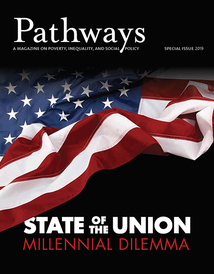State of the Union 2019

The annual Poverty and Inequality Report provides a unified analysis that brings together evidence across such issues as poverty, employment, income inequality, health inequality, economic mobility, and educational access to allow for a comprehensive assessment of where the country stands. In this year’s issue, the country’s leading experts provide the latest evidence on how millennials are faring.
Table of Contents (Special Issue 2019)
With each new generation, there’s inevitably much angst and hand-wringing, but never have we worried as much as we worry about millennials. We review the evidence on whether all that worrying is warranted.
The usual stereotypes have it that millennials are embracing a more diverse and unconventional set of racial and gender identities. Are those stereotypes on the mark?
Often tagged the “student debt generation,” millennials took out more student loans, took out larger student loans, and defaulted more frequently. Here’s a step-by-step accounting of how we let this happen.
Labor force activity has declined especially rapidly among young workers. The good news: We know how to take on this problem.
The imprisonment rate has fallen especially rapidly among black men. Does this much-vaunted trend conceal as much as it reveals?
The payoff to a college degree is as high for millennials as it’s ever been. But it’s partly because millennials who don’t go to college are getting hammered in the labor market.
When millennials entered the labor market during the Great Recession and its aftermath, there were uniformly gloomy predictions about their fate. Does the evidence bear out such gloomy predictions?
Millennials have a mobility problem. And it’s partly because the economy is no longer delivering a steady increase in high-status jobs.
Are millennial women and men working side by side in the new economy? Or are their occupations just as gender-segregated as ever?
Millennial poverty rates at age 30 are no higher than those of Gen Xers at the same age. But this stability hides a problem: Millennials are replacing a falloff in earnings with large increases in government assistance programs.
Housing reforms during the civil rights era helped to narrow the white-black homeownership gap. But those gains have now been completely lost ... and the racial gap in young-adult homeownership is larger for millennials than for any generation in the past century.
Millennials are not replacing face-to-face networks with online ones. Rather, they’re a generation that’s found a way to do it all, forging new online ties while also maintaining the usual face-to-face ones.
It might be thought that, for all their labor market woes, at least millennials now have health care and better health. How does this story fall short?
A comprehensive policy agenda that could help millennials ... and other generations too.
